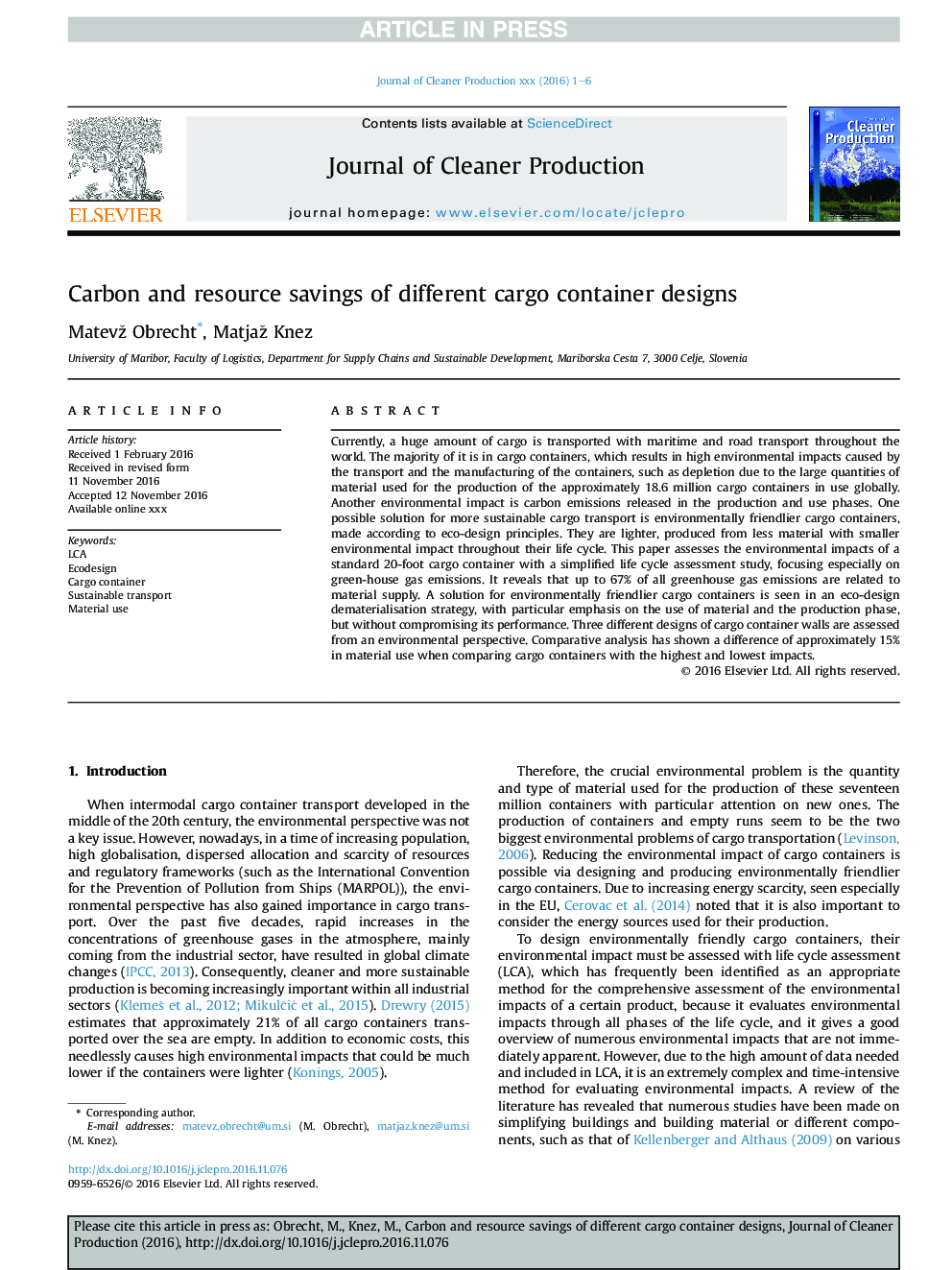| کد مقاله | کد نشریه | سال انتشار | مقاله انگلیسی | نسخه تمام متن |
|---|---|---|---|---|
| 5479700 | 1399306 | 2017 | 6 صفحه PDF | دانلود رایگان |
عنوان انگلیسی مقاله ISI
Carbon and resource savings of different cargo container designs
ترجمه فارسی عنوان
صرفه جویی در کربن و منابع طرح های کانتینری مختلف
دانلود مقاله + سفارش ترجمه
دانلود مقاله ISI انگلیسی
رایگان برای ایرانیان
کلمات کلیدی
ترجمه چکیده
در حال حاضر، مقدار زیادی از بار حمل و نقل حمل و نقل دریایی و جاده در سراسر جهان است. اکثریت آن در ظروف محموله است که منجر به اثرات زیست محیطی بالا ناشی از حمل و نقل و ساخت ظروف مانند تخلیه ناشی از مقادیر زیاد مواد مورد استفاده برای تولید حدود 18.6 میلیون کانتینر محموله در جهان . یکی دیگر از اثرات زیست محیطی انتشار گازهای کربن در مراحل تولید و استفاده آزاد است. یک راه حل ممکن برای حمل و نقل پایدارتر محموله ظروف محموله محرمانه سازگار با محیط زیست است که براساس اصول طراحی محیط زیست ساخته شده است. آنها سبک تر هستند، از مواد کمتری تولید می شوند که اثرات زیست محیطی آنها در طول عمرشان کم است. در این مقاله اثرات زیست محیطی یک کانتینر استاندارد 20 فوت پایه با یک مطالعه ارزیابی چرخه ساده، با تمرکز ویژه بر انتشار گازهای گلخانه ای، بررسی می شود. این نشان می دهد که تا 67 درصد از کل انتشار گازهای گلخانه ای مربوط به عرضه مواد است. یک راه حل برای ظروف محموله محرمانه سازگار با محیط زیست در یک استراتژی جداسازی مواد زیست محیطی طراحی شده است، با تاکید خاص بر استفاده از مواد و فاز تولید، اما بدون رعایت عملکرد آن. سه طرح مختلف دیوار کانتینر محموله از منظر زیست محیطی ارزیابی می شود. تجزیه و تحلیل مقایسه ای تقریبا 15٪ در استفاده از مواد در مقایسه با ظروف حمل و نقل با بالاترین و کمترین اثرات نشان داد.
موضوعات مرتبط
مهندسی و علوم پایه
مهندسی انرژی
انرژی های تجدید پذیر، توسعه پایدار و محیط زیست
چکیده انگلیسی
Currently, a huge amount of cargo is transported with maritime and road transport throughout the world. The majority of it is in cargo containers, which results in high environmental impacts caused by the transport and the manufacturing of the containers, such as depletion due to the large quantities of material used for the production of the approximately 18.6 million cargo containers in use globally. Another environmental impact is carbon emissions released in the production and use phases. One possible solution for more sustainable cargo transport is environmentally friendlier cargo containers, made according to eco-design principles. They are lighter, produced from less material with smaller environmental impact throughout their life cycle. This paper assesses the environmental impacts of a standard 20-foot cargo container with a simplified life cycle assessment study, focusing especially on green-house gas emissions. It reveals that up to 67% of all greenhouse gas emissions are related to material supply. A solution for environmentally friendlier cargo containers is seen in an eco-design dematerialisation strategy, with particular emphasis on the use of material and the production phase, but without compromising its performance. Three different designs of cargo container walls are assessed from an environmental perspective. Comparative analysis has shown a difference of approximately 15% in material use when comparing cargo containers with the highest and lowest impacts.
ناشر
Database: Elsevier - ScienceDirect (ساینس دایرکت)
Journal: Journal of Cleaner Production - Volume 155, Part 1, 1 July 2017, Pages 151-156
Journal: Journal of Cleaner Production - Volume 155, Part 1, 1 July 2017, Pages 151-156
نویسندگان
Matevž Obrecht, Matjaž Knez,
